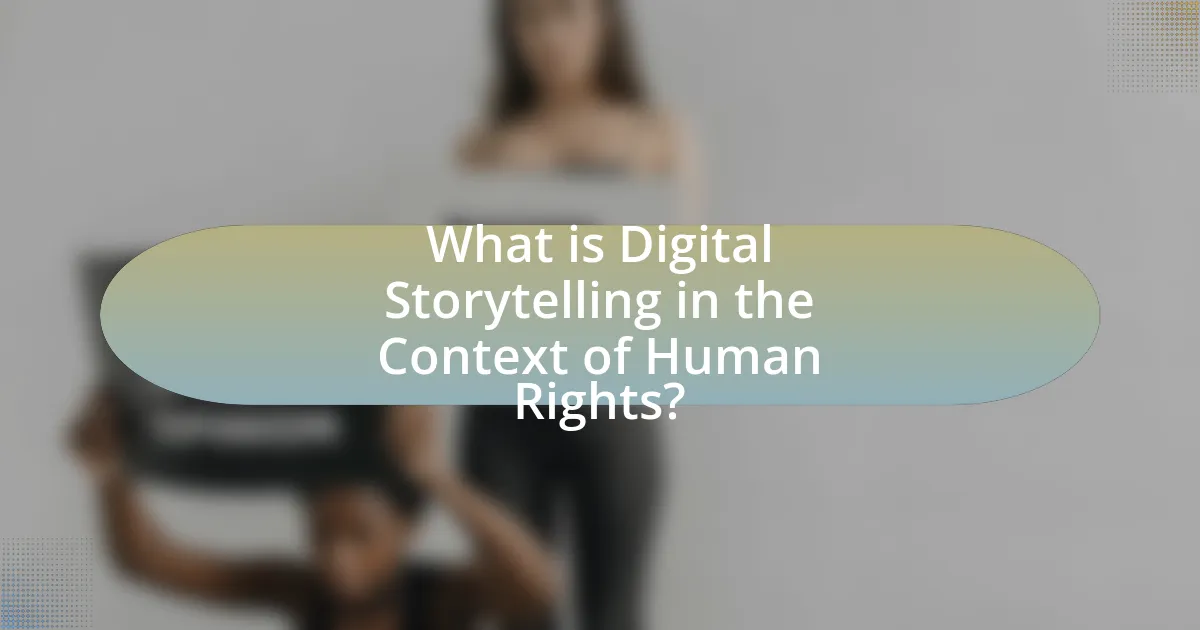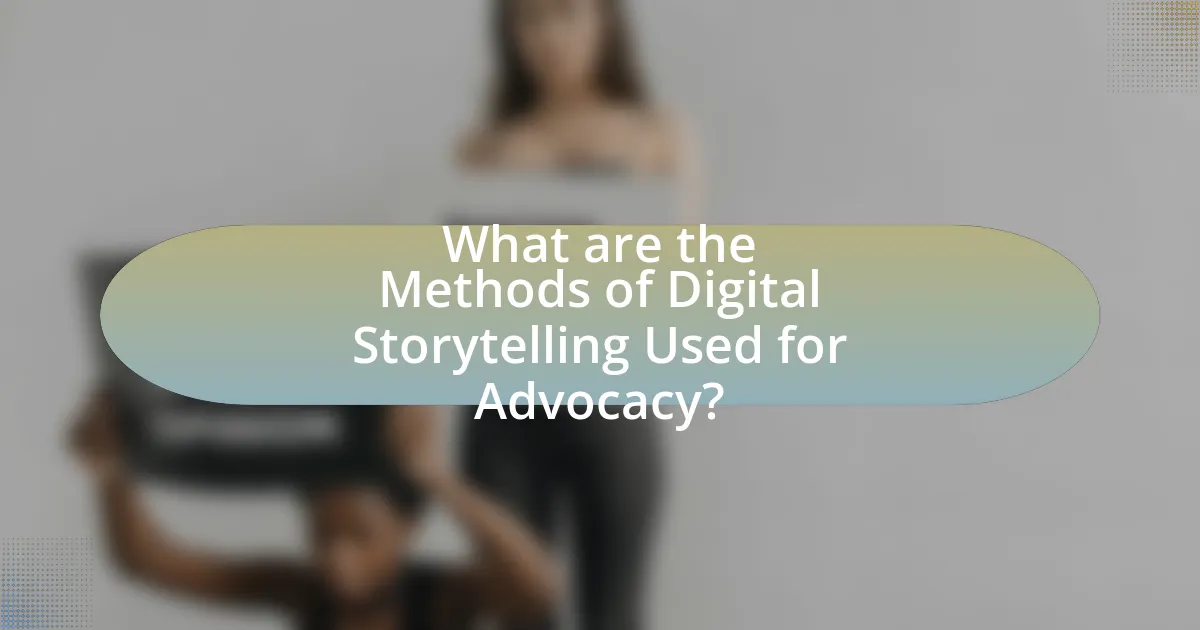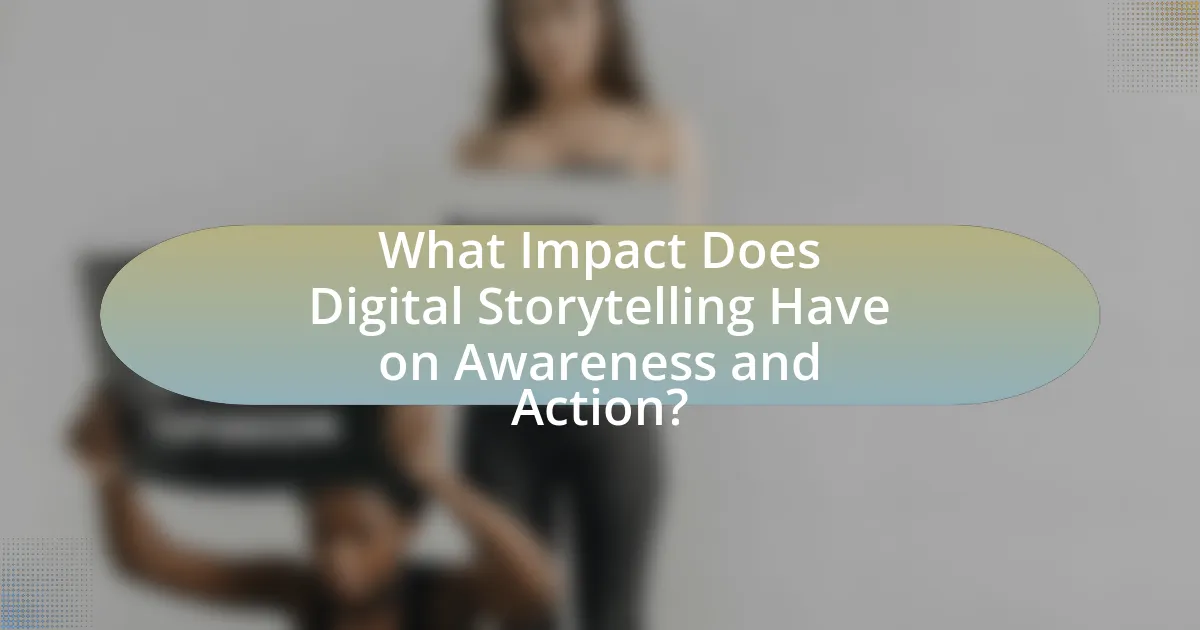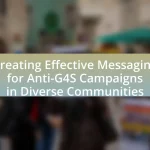Digital storytelling serves as a vital tool for raising awareness about human rights violations associated with G4S, a company facing numerous allegations regarding its treatment of detainees and labor practices. This article explores how digital narratives can humanize complex issues, engage audiences emotionally, and mobilize public support for advocacy efforts. Key elements of effective digital storytelling, including compelling narratives, visual elements, and personal testimonies, are examined, alongside the impact of social media and interactive platforms in amplifying these stories. Additionally, the article addresses the challenges and ethical considerations involved in using digital storytelling for human rights advocacy, emphasizing best practices for creating impactful narratives that resonate with audiences.

What is Digital Storytelling in the Context of Human Rights?
Digital storytelling in the context of human rights is the use of digital media to convey personal narratives that highlight human rights issues and violations. This method allows individuals and communities to share their experiences, fostering empathy and understanding among audiences. For instance, organizations like Witness and Human Rights Watch utilize digital storytelling to document and disseminate accounts of human rights abuses, effectively raising awareness and mobilizing support for victims. Research indicates that visual narratives can significantly impact public perception and advocacy efforts, making digital storytelling a powerful tool for human rights activism.
How does Digital Storytelling raise awareness about human rights violations?
Digital storytelling raises awareness about human rights violations by providing a platform for personal narratives that humanize the issues and engage audiences emotionally. This method allows individuals affected by violations to share their experiences, making the abstract concept of human rights more relatable and urgent. For instance, studies have shown that visual and narrative elements in digital storytelling can increase empathy and understanding among viewers, leading to greater advocacy and action. Research by the Berkman Klein Center for Internet & Society highlights that storytelling can effectively mobilize communities and influence public opinion, demonstrating its power as a tool for social change.
What are the key elements of effective Digital Storytelling?
The key elements of effective digital storytelling include a compelling narrative, emotional engagement, visual elements, interactivity, and a clear message. A compelling narrative captures the audience’s attention and drives the story forward, while emotional engagement fosters a connection between the audience and the content, making the story more relatable. Visual elements, such as images and videos, enhance understanding and retention of the message. Interactivity allows the audience to engage with the content, creating a more immersive experience. Finally, a clear message ensures that the audience understands the core takeaway of the story. These elements are essential for effectively raising awareness about issues, such as human rights violations, by making the content impactful and memorable.
How can narratives influence public perception of human rights issues?
Narratives can significantly influence public perception of human rights issues by shaping emotional connections and framing the context of these issues. For instance, storytelling can humanize abstract concepts, making them relatable and compelling, which can lead to increased empathy and awareness among the audience. Research indicates that narratives that include personal testimonies or vivid imagery can evoke stronger emotional responses, thereby motivating individuals to engage with and advocate for human rights causes. A study published in the Journal of Human Rights Practice found that narratives effectively mobilize public opinion and can lead to tangible changes in policy and social attitudes towards human rights violations.
Why is G4S a significant case study for Digital Storytelling?
G4S is a significant case study for Digital Storytelling because it exemplifies how narrative techniques can effectively highlight human rights violations associated with corporate practices. The company has faced numerous allegations regarding its treatment of detainees and labor practices, making it a focal point for activists and storytellers aiming to raise awareness. Digital storytelling allows for the dissemination of personal accounts and visual evidence, which can engage audiences emotionally and inform them about the complexities of G4S’s operations. For instance, campaigns utilizing social media and video content have successfully mobilized public opinion against G4S, demonstrating the power of storytelling in advocacy.
What human rights violations have been attributed to G4S?
G4S has been attributed with various human rights violations, including excessive use of force, mistreatment of detainees, and involvement in the detention of individuals without due process. Reports from organizations such as Amnesty International and Human Rights Watch have documented instances where G4S personnel were implicated in abusive practices in prisons and immigration detention centers. For example, in the UK, G4S faced allegations of using excessive force against detainees in their custody, leading to serious injuries. Additionally, G4S has been criticized for its role in operating facilities that have been linked to human rights abuses, such as the detention of asylum seekers in inhumane conditions.
How has G4S’s global presence impacted its human rights record?
G4S’s global presence has significantly impacted its human rights record by exposing the company to various allegations of human rights abuses across different countries. For instance, G4S has faced criticism for its role in the management of detention centers and prisons, particularly in Israel and the UK, where reports have documented instances of excessive force and inadequate conditions. Additionally, the company’s operations in conflict zones have raised concerns about complicity in human rights violations, as highlighted by investigations from organizations like Amnesty International and Human Rights Watch. These allegations illustrate how G4S’s extensive international operations have led to scrutiny and accountability issues regarding its treatment of individuals in its care.

What are the Methods of Digital Storytelling Used for Advocacy?
Digital storytelling methods used for advocacy include video narratives, social media campaigns, interactive websites, and podcasts. Video narratives effectively convey personal experiences and emotional connections, making them powerful tools for raising awareness about issues like human rights violations. Social media campaigns leverage platforms like Twitter and Instagram to share stories quickly and widely, engaging audiences in real-time discussions. Interactive websites allow users to explore stories in depth, often incorporating multimedia elements that enhance understanding. Podcasts provide an audio format for storytelling, enabling in-depth discussions and interviews that can reach diverse audiences. These methods collectively enhance the visibility of advocacy efforts and foster community engagement around critical issues.
What platforms are most effective for Digital Storytelling?
The most effective platforms for digital storytelling include social media networks, video-sharing sites, and dedicated storytelling platforms. Social media networks like Facebook and Instagram allow for wide reach and engagement, enabling users to share stories visually and interactively. Video-sharing sites such as YouTube and Vimeo provide a space for longer narratives, allowing for deeper emotional connections through audiovisual content. Dedicated storytelling platforms like Medium and Wattpad offer structured environments for written narratives, fostering community engagement and feedback. These platforms collectively enhance the visibility and impact of stories, particularly in raising awareness about issues such as human rights violations.
How do social media channels enhance the reach of Digital Stories?
Social media channels enhance the reach of digital stories by providing platforms that facilitate rapid sharing and engagement among users. These channels, such as Facebook, Twitter, and Instagram, allow for the dissemination of content to vast audiences, leveraging algorithms that promote popular posts and encourage virality. For instance, a study by the Pew Research Center found that 69% of adults in the U.S. use social media, which significantly increases the potential audience for digital stories. Additionally, social media enables interactive features such as comments, shares, and likes, fostering community discussions and amplifying the message of digital stories related to human rights violations. This interactive engagement can lead to increased awareness and advocacy, as users are more likely to share content that resonates with them, thereby extending the reach beyond the original audience.
What role do visual elements play in Digital Storytelling?
Visual elements are crucial in digital storytelling as they enhance engagement and comprehension. They serve to illustrate narratives, evoke emotions, and provide context, making complex issues more accessible. For instance, studies show that visuals can increase information retention by up to 65%, highlighting their effectiveness in conveying messages. In the context of raising awareness about G4S’s human rights violations, visual elements such as infographics, photographs, and videos can powerfully depict the impact of these violations, fostering empathy and prompting action among viewers.
How can Digital Storytelling be tailored to address G4S’s violations?
Digital storytelling can be tailored to address G4S’s violations by creating compelling narratives that highlight personal experiences of those affected by the company’s actions. These narratives can incorporate multimedia elements such as video interviews, photographs, and infographics to effectively convey the emotional and factual aspects of human rights violations. For instance, using real testimonies from individuals impacted by G4S’s practices can foster empathy and understanding among viewers, making the issue more relatable and urgent. Additionally, integrating data on G4S’s documented violations, such as reports from human rights organizations, can provide a factual basis that reinforces the stories being told. This combination of personal and factual storytelling can mobilize public opinion and encourage advocacy for accountability and change.
What types of stories resonate most with audiences regarding G4S?
Stories that resonate most with audiences regarding G4S typically focus on human rights violations and personal testimonies from affected individuals. These narratives often highlight specific incidents of abuse or neglect, illustrating the real-life impact of G4S’s operations on vulnerable populations. For instance, reports from organizations like Amnesty International have documented cases where G4S personnel were involved in mistreatment of detainees, which effectively engages public empathy and concern. Additionally, stories that emphasize accountability and the call for reform resonate strongly, as they align with the audience’s desire for justice and ethical practices in security services.
How can personal testimonies be integrated into Digital Storytelling?
Personal testimonies can be integrated into digital storytelling by using multimedia formats such as video, audio, and text to convey individual experiences related to G4S’s human rights violations. This approach allows for emotional engagement and authenticity, as personal narratives can illustrate the impact of these violations on individuals’ lives. For instance, incorporating video interviews with affected individuals can provide a powerful visual and auditory representation of their stories, making the content more relatable and impactful. Research indicates that narratives enhance empathy and understanding, which is crucial for raising awareness about human rights issues.

What Impact Does Digital Storytelling Have on Awareness and Action?
Digital storytelling significantly enhances awareness and prompts action regarding social issues, including human rights violations. By combining narrative with multimedia elements, digital storytelling engages audiences emotionally and intellectually, making complex issues more relatable and understandable. Research indicates that stories can increase empathy and motivate individuals to take action; for instance, a study published in the journal “Communication Research” found that narratives can effectively influence attitudes and behaviors by fostering a personal connection to the subject matter. This mechanism is particularly relevant in raising awareness about G4S’s human rights violations, as compelling stories can galvanize public support and advocacy efforts, leading to tangible changes in policy and corporate accountability.
How effective is Digital Storytelling in mobilizing public support?
Digital storytelling is highly effective in mobilizing public support, particularly in raising awareness about human rights violations. This method engages audiences emotionally, making complex issues more relatable and compelling. Research indicates that narratives can significantly influence public perception and action; for instance, a study by the Stanford Social Innovation Review found that storytelling can increase empathy and motivate individuals to support social causes. By presenting personal stories of those affected by G4S’s human rights violations, digital storytelling fosters a deeper understanding and encourages collective action among viewers.
What metrics can be used to measure the impact of Digital Storytelling?
Metrics that can be used to measure the impact of Digital Storytelling include engagement rates, reach, audience retention, and conversion rates. Engagement rates, such as likes, shares, and comments, indicate how well the story resonates with the audience. Reach measures the total number of unique viewers, providing insight into the story’s visibility. Audience retention tracks how long viewers stay engaged with the content, reflecting its effectiveness in maintaining interest. Conversion rates assess the percentage of viewers who take a desired action, such as signing a petition or sharing the story, demonstrating the story’s influence on behavior. These metrics collectively provide a comprehensive understanding of the effectiveness of Digital Storytelling in raising awareness about issues like G4S’s human rights violations.
How can success stories inspire further advocacy against G4S?
Success stories can inspire further advocacy against G4S by demonstrating the tangible impact of collective action and highlighting successful outcomes in challenging the company’s practices. For instance, campaigns that have effectively mobilized public opinion, such as the “Boycott G4S” movement, showcase how grassroots efforts can lead to significant changes, including contract cancellations and increased scrutiny of G4S’s operations. These examples serve as motivational case studies, illustrating that sustained advocacy can yield results, thereby encouraging more individuals and organizations to engage in similar efforts against G4S’s human rights violations.
What challenges exist in using Digital Storytelling for human rights advocacy?
Digital storytelling faces several challenges in human rights advocacy, including issues of accessibility, authenticity, and audience engagement. Accessibility can be limited by technological barriers, as not all target audiences have reliable internet access or digital literacy skills. Authenticity is often questioned, as the representation of human rights violations may be perceived as biased or manipulated, undermining the credibility of the stories. Additionally, engaging audiences effectively can be difficult, as oversaturation of content may lead to desensitization or apathy towards human rights issues. These challenges can hinder the overall impact of digital storytelling in raising awareness about human rights violations, such as those committed by G4S.
How can misinformation affect the effectiveness of Digital Storytelling?
Misinformation can significantly undermine the effectiveness of digital storytelling by distorting the narrative and eroding trust among the audience. When false information is presented alongside or within a digital story, it can lead to confusion, misinterpretation, and a lack of credibility for the message being conveyed. For instance, a study by the Pew Research Center found that 64% of Americans believe that misinformation has a major impact on their understanding of current events, which directly affects how stories about human rights violations are perceived. This erosion of trust can result in decreased engagement and a diminished ability to raise awareness about critical issues, such as G4S’s human rights violations.
What ethical considerations must be taken into account?
Ethical considerations in digital storytelling about G4S’s human rights violations include the need for accuracy, consent, and sensitivity to the subjects involved. Accuracy is crucial to ensure that the narratives presented do not misrepresent the facts or the experiences of individuals affected by G4S’s actions. Consent must be obtained from individuals whose stories are being shared, respecting their autonomy and privacy. Sensitivity involves being aware of the potential emotional impact on both the subjects and the audience, ensuring that the storytelling does not exploit or further harm those depicted. These considerations are essential to maintain integrity and respect in the portrayal of human rights issues.
What are best practices for creating impactful Digital Stories about G4S?
To create impactful digital stories about G4S, focus on authenticity, emotional engagement, and factual accuracy. Authenticity ensures that the narratives reflect real experiences of individuals affected by G4S’s operations, which can enhance credibility. Emotional engagement can be achieved by using personal testimonies and compelling visuals that resonate with the audience, making the stories more relatable and memorable. Factual accuracy is crucial; incorporating verified statistics and documented incidents related to G4S’s human rights violations strengthens the narrative and provides a solid foundation for the claims made. For instance, referencing reports from organizations like Amnesty International or Human Rights Watch can substantiate the stories and highlight the urgency of the issues being addressed.
How can storytellers ensure authenticity in their narratives?
Storytellers can ensure authenticity in their narratives by conducting thorough research and engaging with the communities they represent. This approach allows them to accurately reflect the experiences and perspectives of those affected by G4S’s human rights violations. For instance, utilizing firsthand accounts and testimonies from individuals impacted by these violations enhances the credibility of the narrative. Additionally, incorporating factual data and statistics related to human rights issues, such as reports from organizations like Amnesty International, further substantiates the authenticity of the storytelling. By prioritizing accuracy and representation, storytellers can create narratives that resonate truthfully with their audience.
What strategies can enhance audience engagement and retention?
Effective strategies to enhance audience engagement and retention include utilizing interactive content, personalizing experiences, and leveraging storytelling techniques. Interactive content, such as polls and quizzes, encourages active participation, which has been shown to increase user engagement by up to 70%. Personalization, achieved through data analytics, allows organizations to tailor messages to individual preferences, resulting in a 20% increase in retention rates. Additionally, storytelling techniques create emotional connections, making the content more relatable and memorable; studies indicate that narratives can improve information retention by 65%. These strategies collectively foster a deeper connection with the audience, ensuring sustained interest and involvement.





